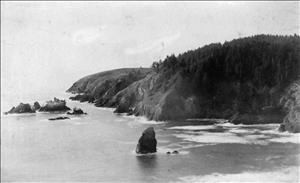On July 18, 1841, the 18-gun U.S. Navy sloop USS Peacock wrecks at foot of the promontory marking the north side of the Columbia River's entrance. The partially submerged sandspit there becomes Peacock Spit. The Peacock is part of the Wilkes Expedition to explore the Pacific Ocean.
United States Exploring Expedition
Peacock, commanded by U.S. Navy Lieutenant William L. Hudson (d. 1862), departed the U.S. Navy Yard at Norfolk, Virginia, on August 18, 1838, as part of a squadron making up the United States Exploring Expedition. Hudson was second in command of the squadron, which had Lieutenant Charles Wilkes (1798-1877) at its head. The squadron's other vessels were the flagship Vincennes with Porpoise, Relief, Sea Gull, and Flying Fish.
The United States Exploring Expedition was the U.S. Navy's first scientific investigation of the Pacific Ocean. President John Quincy Adams originated the idea for the expedition in 1828. He recommended to Congress a nautical investigation "to the improvement of those parts of knowledge which lie beyond the reach of individual acquisition, particularly with regard to geographical and astronomical sciences" (Tyler). Completely rebuilt in 1828, Peacock was the first vessel designated for the expedition, although years would pass before the enterprise became a reality.
The Peacock
Congress in those years appropriated funds for ship repair, but not for new construction. Thus, the 1828 Peacock took the name of a completely dismantled predecessor that had been a U.S. Navy craft from 1813 to 1828. The new Peacock was a 559-ton, ship-rigged (three masts with square sails), 18-gun sloop especially strengthened for exploration work. Built at the New York Navy Yard, she was 118-feet long with a 31.6-foot beam.
Before arriving off Cape Disappointment in 1841, Peacock accompanied other ships of the squadron in two Antarctic cruises and in a survey of the South Pacific Islands. Then she detached for independent survey work south of Hawaii. Although considered the strongest vessel of her class in the Navy, she required extensive repairs at Rio de Janeiro in 1838 after three months at sea. Her carpenter reported many rotted structural timbers during a subsequent stop in Australia. After suffering Antarctic ice damage in January 1840, she returned to that country for repairs before resuming survey work.
Swirling Currents and Shifting Channels
Wilkes directed Hudson to rejoin the squadron at the mouth of the Columbia River no later than May 1, 1841. Arriving from Hawaii where she had stopped for fresh supplies, Peacock sighted Point Adams at the river's southern entrance on the morning of July 17, 1841. Cape Disappointment, at the river's northern entrance, came into view shortly after 5:00 p.m. on the same day.
At 11:30 on the morning of July 18, Peacock attempted to enter the river by following a channel on the northern side. Winds from the northwest intensified while heavy swells insured rough passage. Her helmsman found steering much affected by swirling currents. Hudson had obtained sailing directions from a merchant ship captain in Hawaii, but since then the channel had shifted. Peacock ran aground shortly after 1:00 p.m. She came to rest in an area of water compared by a modern day Columbia River bar pilot to "two giant hammers smashing into each other" (Philbrick).
A Violent Pounding
Strength of current and force of waves quickly made the grounded Peacock unmanageable. Breakers repeatedly lifted the ship and dropped her back to the spit on which she had grounded. Despite efforts to lighten ship by throwing cannon balls and other stores over the side and to stabilize her by bringing down upper masts and putting out anchors, the violent pounding continued. Attempts to pump out the water pouring into the ship were defeated when debris clogged the pumps. The Flying Fish, sailing in company with Peacock, was unable to come to her aid. By 6:00 p.m., there were only nine feet of water under the sloop. At 8:45 p.m., when an anchor chain broke, she was once again broadside to the surf.
When lookouts sighted an Indian canoe in the river around midnight, Hudson ordered three distress flares fired. By morning, it was clear that the ship could not be saved. Hudson had the masts cut away and initiated evacuation of the ship. Boats took the crew, scientific instruments, and as many supplies as could be salvaged to Baker's Bay at the foot of Cape Disappointment. One crewmember suffered severe injuries, but none perished.
Saving the Crew
American missionaries arrived from Point Adams with tents and food. A Hudson's Bay Company official from Fort George (now Astoria) also offered aid. By July 21, Hudson and his crew had relocated to Fort George where they set up a temporary camp, "Peacockville" and marking it with the Peacock's American flag. Below Cape Disappointment, the ocean's force tore the ship apart, leaving only her bowsprit plunged into the sand spit to mark her grave.
On August 7, Vincennes and Porpoise, which had been investigating Puget Sound, arrived off the mouth of the Columbia. At a cost of $9,000, Wilkes purchased the brig Thomas Perkins, then under charter to the Hudson's Bay Company and anchored at Fort George, as a replacement for Peacock. He renamed the brig Oregon, manned her with the Peacock's crew, and went on with Porpoise and Oregon to explore the Columbia as far upriver as the Cascades. The expedition's survey of the river mouth named the fatal spit after the ship it had destroyed.

